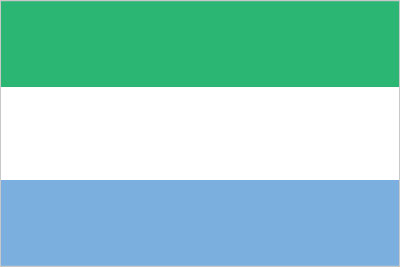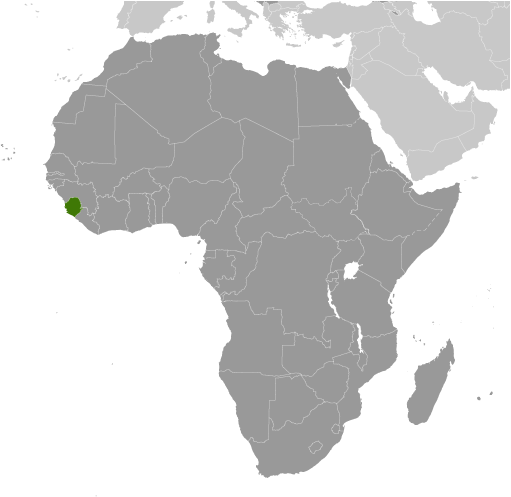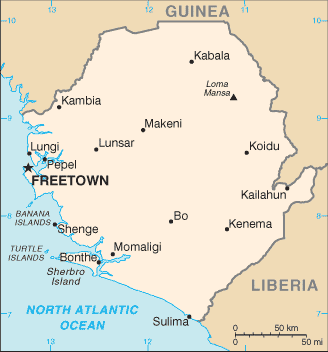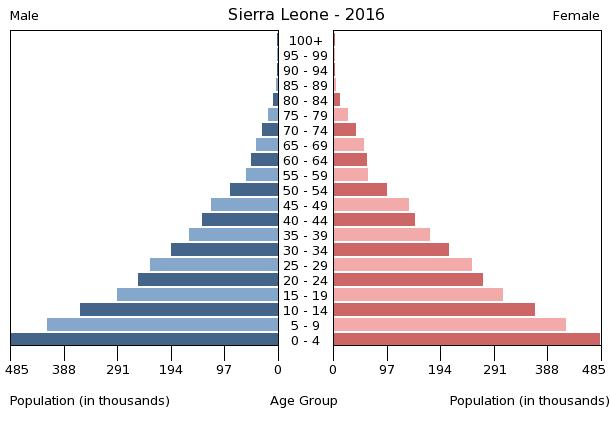Introduction :: SIERRA LEONE
-
The British set up a trading post near present-day Freetown in the 17th century. Originally the trade involved timber and ivory, but later it expanded into slaves. Following the American Revolution, a colony was established in 1787 and Sierra Leone became a destination for resettling black loyalists who had originally been resettled in Nova Scotia. After the abolition of the slave trade in 1807, British crews delivered thousands of Africans liberated from illegal slave ships to Sierra Leone, particularly Freetown. The colony gradually expanded inland during the course of the 19th century; independence was attained in 1961. Democracy is slowly being reestablished after the civil war (1991-2002) that resulted in tens of thousands of deaths and the displacement of more than 2 million people (about one third of the population). The military, which took over full responsibility for security following the departure of UN peacekeepers at the end of 2005, has developed as a guarantor of the country's stability; the armed forces remained on the sideline during the 2007 and 2012 national elections. In March 2014, the closure of the UN Integrated Peacebuilding Office in Sierra Leone marked the end of more than 15 years of peacekeeping and political operations in Sierra Leone. The government's stated priorities include furthering development - including recovering from the Ebola epidemic - creating jobs, and stamping out endemic corruption.
Geography :: SIERRA LEONE
-
Western Africa, bordering the North Atlantic Ocean, between Guinea and Liberia
8 30 N, 11 30 W
Africa
total: 71,740 sq km
land: 71,620 sq km
water: 120 sq km
country comparison to the world: 120
slightly smaller than South Carolina
total: 1,093 km
border countries (2): Guinea 794 km, Liberia 299 km
402 km
territorial sea: 12 nm
contiguous zone: 24 nm
exclusive economic zone: 200 nm
continental shelf: 200 nm
tropical; hot, humid; summer rainy season (May to December); winter dry season (December to April)
coastal belt of mangrove swamps, wooded hill country, upland plateau, mountains in east
mean elevation: 279 m
elevation extremes: lowest point: Atlantic Ocean 0 m
highest point: Loma Mansa (Bintimani) 1,948 m
diamonds, titanium ore, bauxite, iron ore, gold, chromite
agricultural land: 56.2%
arable land 23.4%; permanent crops 2.3%; permanent pasture 30.5%
forest: 37.5%
other: 6.3% (2011 est.)
300 sq km (2012)
population clusters are found in the lower elevations of the south and west; the northern third of the country is less populated
dry, sand-laden harmattan winds blow from the Sahara (December to February); sandstorms, dust storms
rapid population growth pressuring the environment; overharvesting of timber, expansion of cattle grazing, and slash-and-burn agriculture have resulted in deforestation and soil exhaustion; civil war depleted natural resources; overfishing
party to: Biodiversity, Climate Change, Climate Change-Kyoto Protocol, Desertification, Endangered Species, Law of the Sea, Marine Life Conservation, Ozone Layer Protection, Ship Pollution, Wetlands
signed, but not ratified: Environmental Modification
rainfall along the coast can reach 495 cm (195 inches) a year, making it one of the wettest places along coastal, western Africa
People and Society :: SIERRA LEONE
-
6,163,195 (July 2017 est.)
country comparison to the world: 109
noun: Sierra Leonean(s)
adjective: Sierra Leonean
Temne 35%, Mende 31%, Limba 8%, Kono 5%, Kriole 2% (descendants of freed Jamaican slaves who were settled in the Freetown area in the late-18th century; also known as Krio), Mandingo 2%, Loko 2%, other 15% (includes refugees from Liberia's recent civil war, and small numbers of Europeans, Lebanese, Pakistanis, and Indians) (2008 census)
English (official, regular use limited to literate minority), Mende (principal vernacular in the south), Temne (principal vernacular in the north), Krio (English-based Creole, spoken by the descendants of freed Jamaican slaves who were settled in the Freetown area, a lingua franca and a first language for 10% of the population but understood by 95%)
Muslim 60%, indigenous beliefs 30%, Christian 10%
Sierra Leone’s youthful and growing population is driven by its high total fertility rate (TFR) of almost 5 children per woman, which has declined little over the last two decades. Its elevated TFR is sustained by the continued desire for large families, the low level of contraceptive use, and the early start of childbearing. Despite its high TFR, Sierra Leone’s population growth is somewhat tempered by high infant, child, and maternal mortality rates that are among the world’s highest and are a result of poverty, a lack of potable water and sanitation, poor nutrition, limited access to quality health care services, and the prevalence of female genital cutting.
Sierra Leone’s large youth cohort – about 60% of the population is under the age of 25 – continues to struggle with high levels of unemployment, which was one of the major causes of the country’s 1991-2002 civil war and remains a threat to stability today. Its estimated 60% youth unemployment rate is attributed to high levels of illiteracy and unskilled labor, a lack of private sector jobs, and low pay.
Sierra Leone has been a source of and destination for refugees. Sierra Leone’s civil war internally displaced as many as 2 million people, or almost half the population, and forced almost another half million to seek refuge in neighboring countries (370,000 Sierra Leoneans fled to Guinea and 120,000 to Liberia). The UNHCR has helped almost 180,000 Sierra Leoneans to return home, while more than 90,000 others have repatriated on their own. Of the more than 65,000 Liberians who took refuge in Sierra Leone during their country’s civil war (1989-2003), about 50,000 have been voluntarily repatriated by the UNHCR and others have returned home independently. As of 2015, less than 1,000 Liberians still reside in Sierra Leone.
0-14 years: 41.82% (male 1,286,681/female 1,290,924)
15-24 years: 18.56% (male 556,478/female 587,454)
25-54 years: 32.16% (male 949,264/female 1,032,783)
55-64 years: 3.7% (male 106,706/female 121,111)
65 years and over: 3.76% (male 96,285/female 135,509) (2017 est.)
population pyramid:

Africa
::SIERRA LEONE

Population Pyramid
A population pyramid illustrates the age and sex structure of a country's population and may provide insights about political and social stability, as well as economic development. The population is distributed along the horizontal axis, with males shown on the left and females on the right. The male and female populations are broken down into 5-year age groups represented as horizontal bars along the vertical axis, with the youngest age groups at the bottom and the oldest at the top. The shape of the population pyramid gradually evolves over time based on fertility, mortality, and international migration trends.
For additional information, please see the entry for Population pyramid on the Definitions and Notes page under the References tab.
total dependency ratio: 82.6
youth dependency ratio: 78
elderly dependency ratio: 4.6
potential support ratio: 21.9 (2015 est.)
total: 19 years
male: 18.4 years
female: 19.6 years (2017 est.)
country comparison to the world: 202
2.38% (2017 est.)
country comparison to the world: 29
36.3 births/1,000 population (2017 est.)
country comparison to the world: 15
10.4 deaths/1,000 population (2017 est.)
country comparison to the world: 34
-2.1 migrant(s)/1,000 population (2017 est.)
country comparison to the world: 165
population clusters are found in the lower elevations of the south and west; the northern third of the country is less populated
urban population: 40.7% of total population (2017)
rate of urbanization: 2.72% annual rate of change (2015-20 est.)
FREETOWN (capital) 1.007 million (2015)
at birth: 1.03 male(s)/female
0-14 years: 1 male(s)/female
15-24 years: 0.94 male(s)/female
25-54 years: 0.92 male(s)/female
55-64 years: 0.86 male(s)/female
65 years and over: 0.73 male(s)/female
total population: 0.95 male(s)/female (2016 est.)
19.2 years
note: median age at first birth among women 25-29 (2013 est.)
1,360 deaths/100,000 live births (2015 est.)
country comparison to the world: 1
total: 68.4 deaths/1,000 live births
male: 76.6 deaths/1,000 live births
female: 59.8 deaths/1,000 live births (2017 est.)
country comparison to the world: 10
total population: 58.6 years
male: 56 years
female: 61.3 years (2017 est.)
country comparison to the world: 209
4.73 children born/woman (2017 est.)
country comparison to the world: 20
16.6% (2013)
11.1% of GDP (2014)
country comparison to the world: 13
0.02 physicians/1,000 population (2010)
0.4 beds/1,000 population (2006)
improved:
urban: 84.9% of population
rural: 47.8% of population
total: 62.6% of population
unimproved:
urban: 15.1% of population
rural: 52.2% of population
total: 37.4% of population (2015 est.)
improved:
urban: 22.8% of population
rural: 6.9% of population
total: 13.3% of population
unimproved:
urban: 77.2% of population
rural: 93.1% of population
total: 86.7% of population (2015 est.)
1.7% (2016 est.)
country comparison to the world: 28
67,000 (2016 est.)
country comparison to the world: 51
2,800 (2016 est.)
country comparison to the world: 46
degree of risk: very high
food or waterborne diseases: bacterial and protozoal diarrhea, hepatitis A, and typhoid fever
vectorborne diseases: malaria, dengue fever, and yellow fever
water contact disease: schistosomiasis
animal contact disease: rabies
aerosolized dust or soil contact disease: Lassa fever (2016)
8.7% (2016)
country comparison to the world: 147
18.1% (2013)
country comparison to the world: 34
2.7% of GDP (2014)
country comparison to the world: 141
definition: age 15 and over can read and write English, Mende, Temne, or Arabic
total population: 48.1%
male: 58.7%
female: 37.7% (2015 est.)
Government :: SIERRA LEONE
-
conventional long form: Republic of Sierra Leone
conventional short form: Sierra Leone
local long form: Republic of Sierra Leone
local short form: Sierra Leone
etymology: the Portuguese explorer Pedro de SINTRA named the country "Serra Leoa" (Lion Mountains) for the impressive mountains he saw while sailing the West African coast in 1462
presidential republic
name: Freetown
geographic coordinates: 8 29 N, 13 14 W
time difference: UTC 0 (5 hours ahead of Washington, DC, during Standard Time)
3 provinces and 1 area*; Eastern, Northern, Southern, Western*
27 April 1961 (from the UK)
Independence Day, 27 April (1961)
history: several previous; latest effective 1 October 1991
amendments: proposed by Parliament; passage of amendments requires at least two-thirds majority vote of Parliament in two successive readings and assent by the president of the republic; passage of amendments affecting fundamental rights and freedoms and many other constitutional sections also requires approval in a referendum with participation of at least one-half of qualified voters and at least two-thirds of votes cast; amended several times, last in 2013 (2017)
mixed legal system of English common law and customary law
has not submitted an ICJ jurisdiction declaration; accepts ICCt jurisdiction
citizenship by birth: no
citizenship by descent only: at least one parent or grandparent must be a citizen of Sierra Leone
dual citizenship recognized: yes
residency requirement for naturalization: 5 years
18 years of age; universal
chief of state: President Ernest Bai KOROMA (since 17 September 2007); note - the president is both chief of state and head of government
head of government: President Ernest Bai KOROMA (since 17 September 2007)
cabinet: Ministers of State appointed by the president, approved by Parliament; the cabinet is responsible to the president
elections/appointments: president directly elected by absolute majority popular vote in 2 rounds if needed for a 5-year term (eligible for a second term); election last held on 17 November 2012 (next to be on 7 March 2018)
election results: Ernest Bai KOROMA reelected president; percent of vote - Ernest Bai KOROMA (APC) 58.7%, Julius Maada BIO (SLPP) 37.4%, other 3.9%
description: unicameral Parliament (124 seats; 112 members directly elected in single-seat constituencies by simple majority vote and 12 seats filled in separate elections by non-partisan members of Parliament called "paramount chiefs;" members serve 5-year terms)
elections: last held on 17 November 2012 (next to be held on 7 March 2018)
election results: percent of vote by party - APC 53.7%, SLPP 38.3%, other 8.0%; seats by party - APC 67, SLPP 42
highest court(s): Superior Court of Judicature (consists of the Supreme Court - at the apex - with the chief justice and 4 other judges, the Court of Appeal with the chief justice and 7 other judges, and the High Court of Justice with the chief justice and 9 other judges; note – the Judicature has jurisdiction in all civil, criminal, and constitutional matters
judge selection and term of office: Supreme Court chief justice and other judges of the Judicature appointed by the president on the advice of the Judicial and Legal Service Commission (a 7-member independent body of judges, presidential appointees, and the Commission chairman) and are subject to the approval of Parliament; all Judicature judges appointed until retirement at age 65
subordinate courts: magistrates' courts; District Appeals Court; local courts
All People's Congress or APC [Ernest Bai KOROMA]
Sierra Leone People's Party or SLPP [Sumanoh KAPEN]
numerous other parties
student unions; trade unions
ACP, AfDB, AU, C, ECOWAS, EITI (compliant country), FAO, G-77, IAEA, IBRD, ICAO, ICCt, ICRM, IDA, IDB, IFAD, IFC, IFRCS, IHO (pending member), ILO, IMF, IMO, Interpol, IOC, IOM, IPU, ISO (correspondent), ITU, ITUC (NGOs), MIGA, MINUSMA, NAM, OIC, OPCW, UN, UNAMID, UNCTAD, UNESCO, UNIDO, UNIFIL, UNISFA, UNWTO, UPU, WCO, WFTU (NGOs), WHO, WIPO, WMO, WTO
chief of mission: Ambassador Bockari Kortu STEVENS (since 4 April 2008)
chancery: 1701 19th Street NW, Washington, DC 20009
telephone: [1] (202) 939-9261 through 9263
FAX: [1] (202) 483-1793
chief of mission: Ambassador Maria E. BREWER (since 20 December 2017)
embassy: Southridge-Hill Station, Freetown
mailing address: use embassy street address
telephone: [232] 99 1055 00
FAX: [232] 99 515 355
three equal horizontal bands of light green (top), white, and light blue; green symbolizes agriculture, mountains, and natural resources, white represents unity and justice, and blue the sea and the natural harbor in Freetown
lion; national colors: green, white, blue
name: "High We Exalt Thee, Realm of the Free"
lyrics/music: Clifford Nelson FYLE/John Joseph AKA
note: adopted 1961
Economy :: SIERRA LEONE
-
Sierra Leone is extremely poor and nearly half of the working-age population engages in subsistence agriculture. The country possesses substantial mineral, agricultural, and fishery resources, but it is still recovering from a civil war that destroyed most institutions before ending in the early 2000s.
In recent years, economic growth has been driven by mining - particularly iron ore. The country’s principal exports are iron ore, diamonds, and rutile, and the economy is vulnerable to fluctuations in international prices. Until 2014, the government had relied on external assistance to support its budget, but it was gradually becoming more independent. The Ebola outbreak of 2014 and 2015, combined with falling global commodities prices, caused a significant contraction of economic activity in all areas. While the World Health Organization declared an end to the Ebola outbreak in Sierra Leone in November 2015, low commodity prices in 2015-2016 contributed to the country’s biggest fiscal shortfall since 2001. In 2017, increased iron ore exports are expected to support modest economic growth. Non-mining activities will remain constrained by inadequate infrastructure, such as power and roads, even though power sector projects may provide some additional electricity capacity in the near term.
Continued economic growth will depend on rising commodities prices and increased efforts to diversify the sources of growth. Pervasive corruption and undeveloped human capital will continue to deter foreign investors. Sustained international donor support in the near future will partially offset these fiscal constraints.
$10.9 billion (2016 est.)
$10.14 billion (2015 est.)
$12.62 billion (2014 est.)
note: data are in 2016 dollars
country comparison to the world: 157
$3.716 billion (2016 est.)
6.1% (2016 est.)
-20.5% (2015 est.)
4.6% (2014 est.)
country comparison to the world: 41
$1,700 (2016 est.)
$1,600 (2015 est.)
$2,100 (2014 est.)
note: data are in 2016 dollars
country comparison to the world: 212
-9.3% of GDP (2016 est.)
-5.9% of GDP (2015 est.)
-7.2% of GDP (2014 est.)
country comparison to the world: 177
household consumption: 102.2%
government consumption: 10.4%
investment in fixed capital: 16.8%
investment in inventories: 1%
exports of goods and services: 23.5%
imports of goods and services: -53.9% (2016 est.)
agriculture: 61.4%
industry: 5.9%
services: 32.7% (2016 est.)
rice, coffee, cocoa, palm kernels, palm oil, peanuts, cashews; poultry, cattle, sheep, pigs; fish
diamond mining; iron ore, rutile and bauxite mining; small-scale manufacturing (beverages, textiles, footwear)
26.2% (2016 est.)
country comparison to the world: 1
2.863 million (2016 est.)
country comparison to the world: 106
agriculture: 61.1%
industry: 5.5%
services: 33.4% (2014 est.)
9.1% (2014 est.)
country comparison to the world: 118
70.2% (2004 est.)
lowest 10%: 2.6%
highest 10%: 33.6% (2003)
34 (2011)
62.9 (1989)
country comparison to the world: 101
revenues: $574.7 million
expenditures: $877.4 million (2016 est.)
14.4% of GDP (2016 est.)
country comparison to the world: 195
-7.6% of GDP (2016 est.)
country comparison to the world: 190
54.9% of GDP (2016 est.)
45.7% of GDP (2015 est.)
country comparison to the world: 86
calendar year
11.5% (2016 est.)
6.7% (2015 est.)
country comparison to the world: 204
NA%
18% (31 December 2016 est.)
18.73% (31 December 2015 est.)
country comparison to the world: 21
$381.8 million (31 December 2016 est.)
$457.4 million (31 December 2015 est.)
country comparison to the world: 171
$847.2 million (31 December 2016 est.)
$917.2 million (31 December 2015 est.)
country comparison to the world: 174
$527.6 million (31 December 2016 est.)
$569.4 million (31 December 2015 est.)
country comparison to the world: 175
$NA
$-733 million (2016 est.)
$-744.8 million (2015 est.)
country comparison to the world: 111
$670 million (2016 est.)
$581 million (2015 est.)
country comparison to the world: 168
iron ore, diamonds, rutile, cocoa, coffee, fish
Cote dIvoire 31.7%, US 28.3%, Belgium 17.7%, China 6.6% (2016)
$1.316 billion (2016 est.)
$1.347 billion (2015 est.)
country comparison to the world: 172
foodstuffs, machinery and equipment, fuels and lubricants, chemicals
China 12.5%, US 9.7%, India 7.8%, UAE 7.2%, Senegal 6.2%, Belgium 5.5%, Turkey 5.5%, UK 4.7% (2016)
$1.503 billion (31 December 2016 est.)
$1.378 billion (31 December 2015 est.)
country comparison to the world: 158
$1.832 billion (31 December 2016 est.)
$1.499 billion (31 December 2015 est.)
country comparison to the world: 115
$9.7 million (31 December 2015 est.)
$6.7 million (31 December 2014 est.)
country comparison to the world: 110
leones (SLL) per US dollar -
6,289.9 (2016 est.)
6,289.9 (2015 est.)
5,080.8 (2014 est.)
4,524.2 (2013 est.)
4,344 (2012 est.)
Energy :: SIERRA LEONE
-
population without electricity: 5,800,000
electrification - total population: 5%
electrification - urban areas: 11%
electrification - rural areas: 1% (2013)
175 million kWh (2015 est.)
country comparison to the world: 192
162.8 million kWh (2015 est.)
country comparison to the world: 194
0 kWh (2016 est.)
country comparison to the world: 196
0 kWh (2016 est.)
country comparison to the world: 200
81,000 kW (2015 est.)
country comparison to the world: 183
33.3% of total installed capacity (2015 est.)
country comparison to the world: 182
0% of total installed capacity (2015 est.)
country comparison to the world: 181
66.7% of total installed capacity (2015 est.)
country comparison to the world: 20
0% of total installed capacity (2015 est.)
country comparison to the world: 204
0 bbl/day (2016 est.)
country comparison to the world: 193
0 bbl/day (2014 est.)
country comparison to the world: 190
0 bbl/day (2014 est.)
country comparison to the world: 189
0 bbl (1 January 2017 es)
country comparison to the world: 192
0 bbl/day (2014 est.)
country comparison to the world: 197
7,500 bbl/day (2015 est.)
country comparison to the world: 164
0 bbl/day (2014 est.)
country comparison to the world: 197
7,354 bbl/day (2014 est.)
country comparison to the world: 151
0 cu m (2013 est.)
country comparison to the world: 193
0 cu m (2013 est.)
country comparison to the world: 130
0 cu m (2013 est.)
country comparison to the world: 182
0 cu m (2013 est.)
country comparison to the world: 187
0 cu m (1 January 2014 es)
country comparison to the world: 194
1.4 million Mt (2013 est.)
country comparison to the world: 159
Communications :: SIERRA LEONE
-
total subscriptions: 17,000
subscriptions per 100 inhabitants: less than 1 (July 2016 est.)
country comparison to the world: 192
total: 6,279,270
subscriptions per 100 inhabitants: 104 (July 2016 est.)
country comparison to the world: 120
general assessment: telephone service improving with the expansion of the mobile sector
domestic: the national microwave radio relay trunk system connects Freetown to Bo and Kenema; mobile-cellular service has grown rapidly from a small base, overcoming the deficiencies of the fixed-line sector
international: country code - 232; satellite earth station - 1 Intelsat (Atlantic Ocean) (2016)
1 government-owned TV station; 3 private TV stations; a pay-TV service began operations in late 2007; 1 government-owned national radio station; about two-dozen private radio stations primarily clustered in major cities; transmissions of several international broadcasters are available (2016)
.sl
total: 708,615
percent of population: 11.8% (July 2016 est.)
country comparison to the world: 173
Transportation :: SIERRA LEONE
-
number of registered air carriers:
inventory of registered aircraft operated by air carriers:
annual passenger traffic on registered air carriers: 50,193
annual freight traffic on registered air carriers: 0 mt-km (2015)
9L (2016)
8 (2013)
country comparison to the world: 164
total: 1
over 3,047 m: 1 (2017)
total: 7
914 to 1,523 m: 7 (2013)
2 (2013)
total: 11,300 km
paved: 904 km
unpaved: 10,396 km (2002)
country comparison to the world: 131
800 km (600 km navigable year-round) (2011)
country comparison to the world: 71
total: 215
by type: bulk carrier 22, cargo 120, carrier 2, chemical tanker 19, container 6, liquefied gas 3, passenger/cargo 2, petroleum tanker 28, refrigerated cargo 7, roll on/roll off 4, specialized tanker 1, vehicle carrier 1
foreign-owned: 98 (Bangladesh 1, China 19, Cyprus 2, Egypt 3, Estonia 2, Hong Kong 7, Japan 4, Lebanon 2, North Korea 2, Romania 2, Russia 7, Singapore 9, Syria 13, Taiwan 7, Turkey 9, UAE 1, UK 1, Ukraine 5, Yemen 2) (2010)
country comparison to the world: 34
major seaport(s): Freetown, Pepel, Sherbro Islands
Military and Security :: SIERRA LEONE
-
0.81% of GDP (2016)
0.92% of GDP (2015)
0.97% of GDP (2014)
0.64% of GDP (2013)
0.78% of GDP (2012)
country comparison to the world: 118
Republic of Sierra Leone Armed Forces (RSLAF): Army (includes Maritime Wing and Air Wing) (2013)
18 is the legal minimum age for voluntary military service (younger with parental consent); women are eligible to serve; no conscription; candidates must be HIV negative (2012)
Transnational Issues :: SIERRA LEONE
-
Sierra Leone opposes Guinean troops' continued occupation of Yenga, a small village on the Makona River that serves as a border with Guinea; Guinea's forces came to Yenga in the mid-1990s to help the Sierra Leonean military to suppress rebels and to secure their common border but have remained there even after both countries signed a 2005 agreement acknowledging that Yenga belonged to Sierra Leone; in 2012, the two sides signed a declaration to demilitarize the area














